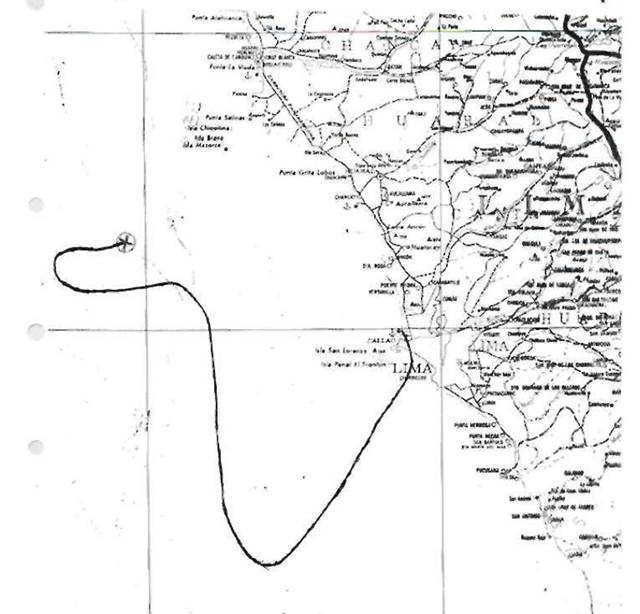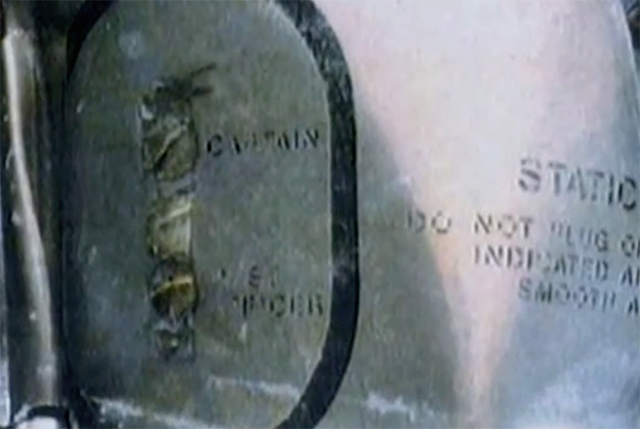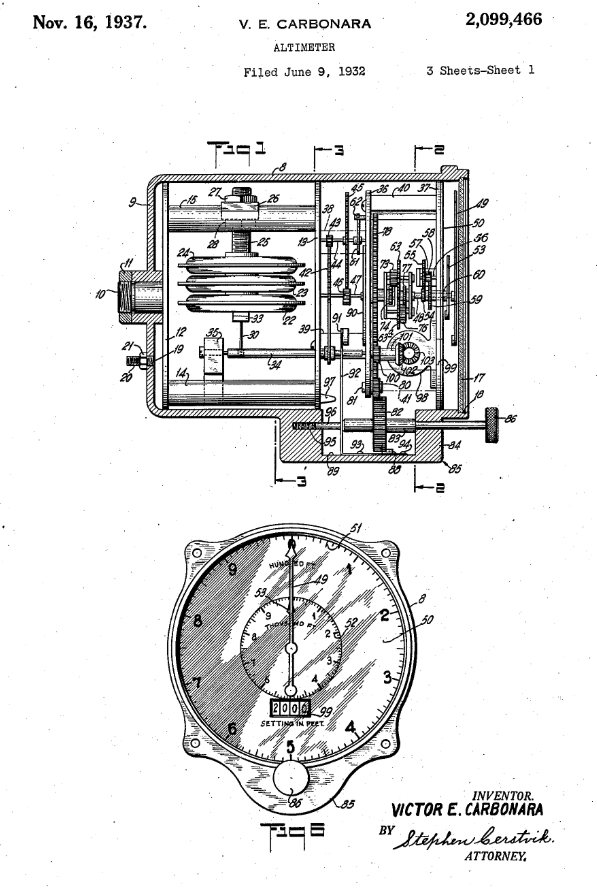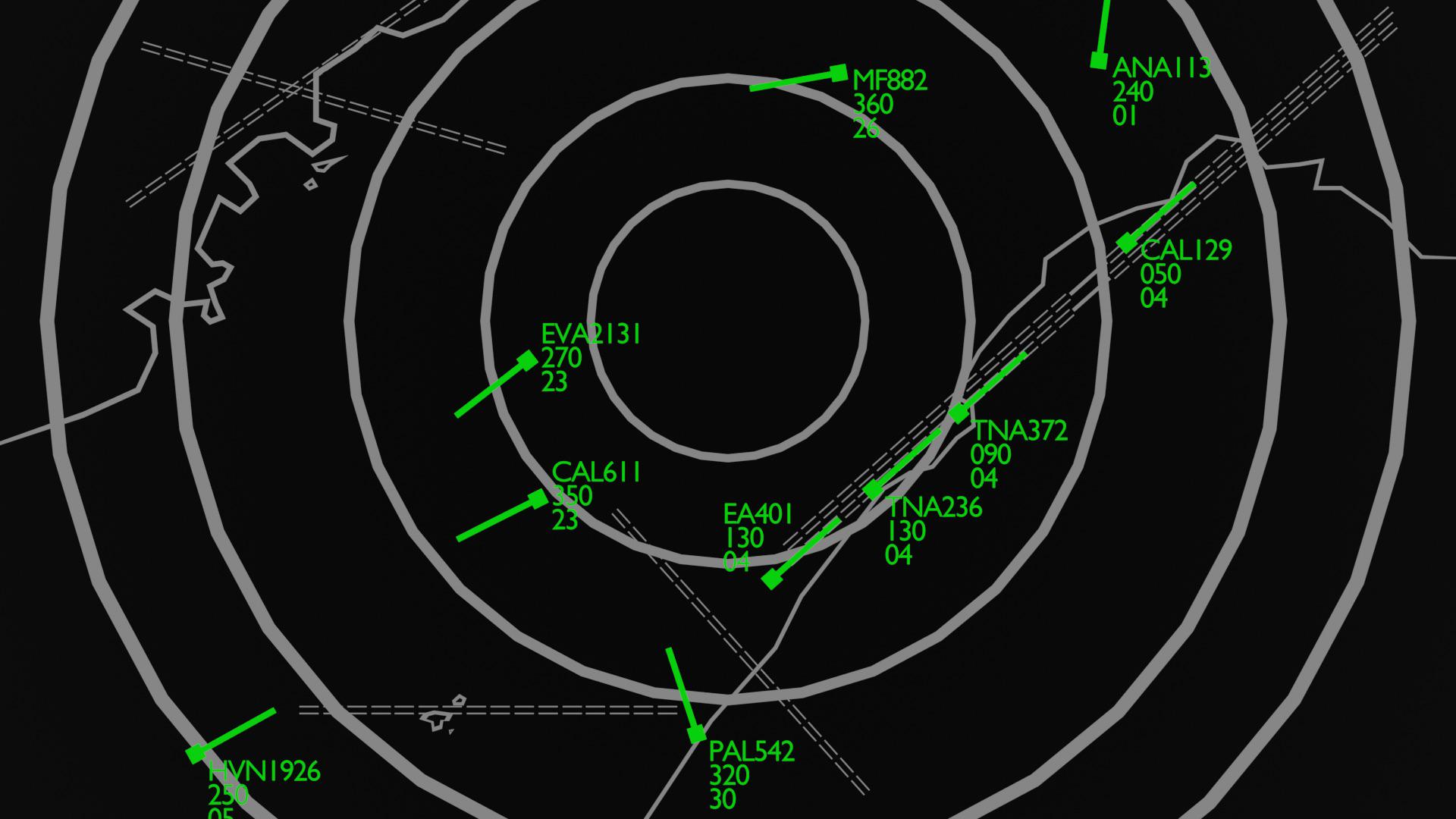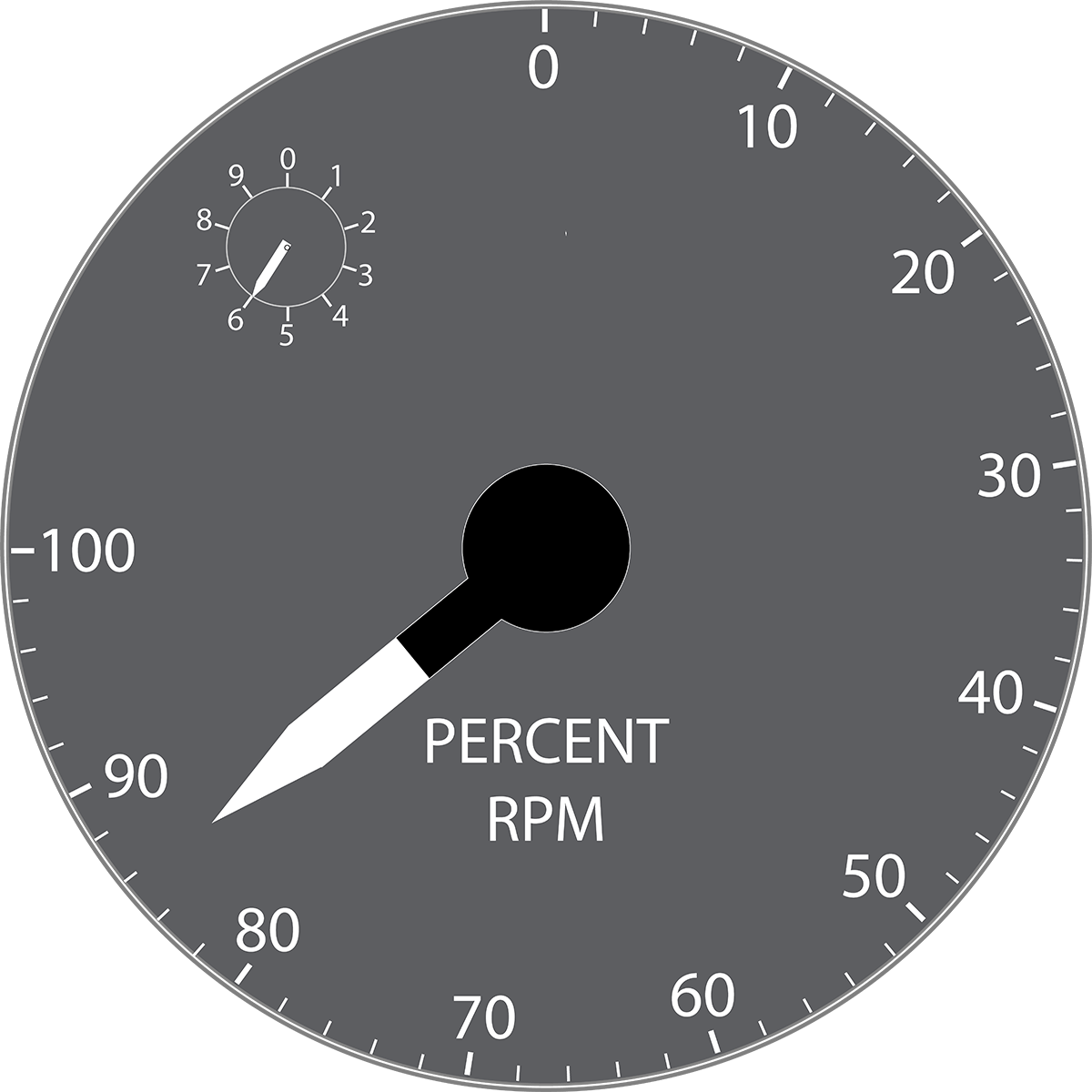Imagine yourself at the controls of a state of the art heavy jet with a crew of 9 and 61 passengers on board. You have confidence in the aircraft, the airline, and your maintainers. Everyone else, likewise, have confidence in you. They should, you have built a fine career with no accidents on your record. You know what you are doing. Your first officer is also highly experienced and you happily give him the takeoff from the right seat. Taking off from Lima-Jorge Chavez International Airport, everything has been normal until just after gear retraction. As the first officer settles on V2+10, just like thousands of times before, but the altimeters are frozen: yours, the first officer's, and the standby. They aren't moving. Now what?
— James Albright

Updated:
2025-12-10
This was in 1996, and your modern Boeing 757 has the latest Electronic Flight Instrument System (EFIS) and Inertial Reference Systems (IRSs). Your altimetry goes through two Air Data Computers (ADCs), except the standby system, which is conventional. You don't have GPS, which had only been approved for installation on the 757 the previous year. But your airline, AeroPerú, had not yet installed any type of GPS.
We are, of course, talking about AeroPerú Flight 603, which crashed after a confusing situation which pushed its pilots into a catastrophic loss of situational awareness, resulting in the loss of all lives. The pilots were good, but perhaps not as well prepared as they could have been. Let's look at:
1 — The flight from the pilots' perspective
And how they could have been saved by:
3 — Knowledge of prior accidents
4 — Understanding the vulnerabilities of pitot-static systems
6 — An important last line of defense
- Date: 02 OCT 1996
- Time: 0042 L
- Type: Boeing 757-23A
- Operator: AeroPerú
- Registration: N52AW
- Fatalities: 9 of 9 crew, 61 of 61 passengers
- Aircraft Fate: Destroyed
- Phase: En route
- Airport: (Departure) Lima-Jorge Chavez International Airport (LIM/SPIM), Peru
- Airport: (Destination) Santiago-Arturo Merino Benitez Airport (SCL/SCEL), Chile

1
The flight
(From the pilots' perspective)
You cannot really appreciate how easy it is to lose situational awareness in this scenario without looking at it through the pilots' eyes. We'll try to do that here by following the Cockpit Voice Recorder. All times shown are local.
The captain was highly experienced with nearly 22,000 total flight hours, over 1,500 in type. The first officer had nearly 8,000 total flight hours and just over 700 hours in type.
The winds were calm and the sky was covered by a low ceiling of clouds at 270 meters with tops around 950 meters (around 3,100 feet). Taking off to the west from Lima at midnight with the moon not yet risen from the east, it is likely they had no discernible horizon as the sky tends to blend into the ocean. We begin just after the takeoff roll begins. The first officer is the pilot flying.
00:41:37 Cabin: (SOUND SIMILAR TO ENGINES ACCELERATING)
00:41:44 Pilot: POWER'S SET
00:41:45 Copilot: POWER'S SET
00:41:47 Pilot: EIGHTY KNOTS
00:41:48 Copilot: CHECKED
00:41:57 Pilot: V ONE
00:41:58 Pilot: ROTATE
00:41:01 Pilot: V TWO
00:42:02 Cabin: (CLICK SOUND )
00:42:03 Pilot: POSITIVE
00:42:05 Copilot: GEAR UP
00:42:05 Cabin: (SOUND SIMILAR TO LANDING GEAR CONTROL MOVING)
00:42:10 Pilot: RIGHT, V TWO PLUS TEN
00:42:12 Copilot: THE ALTIMETERS ARE STUCK
00:42:14 Cabin: (SOUND SIMILAR TO WINDSHEAR ALARM - THREE TIMES)
00:42:16 Cabin: (SOUND SIMILAR TO WHEELS BREAKING)
00:42:23 Copilot: HEY, ALTIMETERS HAVE STUCK
00:42:26 Pilot: YEAH
00:42:26 Copilot: ALL OF THEM
00:42:28 Pilot: THIS IS REALLY NEW... KEEP V TWO PLUS TEN... V TWO PLUS TEN
Up to this point, they had what looked like perfectly normal airspeed indications during takeoff followed by all three altimeters stuck and a momentary windshear alert. The winds were calm for takeoff and neither pilot commented about the windshear alarms. The copilot, who was the pilot flying, made several comments about the speed. The captain, the pilot monitoring, was concerned about the climb.
00:42:38 Pilot: V TWO PLUS TEN... V TWO PLUS TEN
00:42:40 Copilot: THE SPEED...
00:42:41 Pilot: EH?
00:42:42 Copilot: THE SPEED...
00:42:43 Pilot: YEAH RIGHT, V TWO PLUS TEN...
00:42:49 Pilot: WHAT HAPPEN, NOT CLIMBING?
00:42:51 Copilot: I'M CLIMBING, BUT THE SPEED?
00:42:53 Pilot: HOLD IT, NO... KEEP THE SPEED.
00:42:54 Tower: AEROPERU 603, 119.7.
00:42:57 Pilot to tower: 603
00:43:00 Pilot: POSITIVE, EH, PUT TEN DEGREES, WE ARE DESCENDING.
It appears the copilot is concerned he cannot maintain V2 + 10 at normal pitch settings, but only repeats "The speed" when trying to articulate this. The captain is concerned the altimeter doesn't reflect a climb and just assumes the copilot is failing to maintain airspeed. The captain, very smartly, asks the copilot to maintain a positive 10° pitch in response to the fact his altimeters are indicating a descent.
A Rudder Ratio warning alarm activates.
00:43:11 Pilot: HOW STRANGE...
00:43:15 Pilot: TURN TO THE RIGHT... WELL... GO UP! GO UP! GO UP! GO UP! GO UP! GO UP!
00:43:22 Copilot: I'M...
00:43:26 Pilot: GO UP! YOU ARE GOING DOWN... EH, DAVID.
00:43:29 Copilot: I AM UP, BUT THE SPEED...
The Mach Trim warning now activates, adding to the confusion.
From 00:43:31 the crew start to receive rudder ratio and mach speed trim warnings, which are repeated throughout the flight, distracting their attention and adding to the problem of multiple alarms and warnings which saturate and bewilder them, creating confusion and chaos which they do not manage to control, neglecting the flight and not paying attention to those alarms which are genuine.
Source: Accident Report, §21.b.4
The pilots continue to debate the warnings, "the speed," and the need to "Go Up! Go Up!" The copilot declares an emergency even as he is the pilot flying, the captain insists on the autopilot even as he is the pilot monitoring. After two minutes of this, the captain finally takes over as pilot flying and they agree on a plan of action to return to Lima. They realize they cannot trust the altimeters.
00:46:01 Copilot to ATC: TURNING RIGHT, COURSE 330
00:45:03 ATC Lima: AFFIRMATIVE, AND KEEP PRESENT ALTITUDE
00:46:05 Pilot: ALTITUDE? WE CAN'T... WE ARE GOING UP.
00:46:07 Copilot to ATC: WHAT LEVEL DO WE HAVE, DO WE HAVE 4,000 FEET? LET'S SEE IF YOU CONFIRM US...
00:46:11 ATC Lima: CORRECT, KEEPING 4,000
00:46:15 Copilot to ATC: WE ARE KEEPING 4,000
00:46:16 ATC Lima: AFFIRMATIVE
00:46:37 Pilot: OK, NEVER MIND, WE KEEP GOING UP. WE ARE FLYING WITHOUT SPEED, IT CAN'T BE... LET'S SEE, RESPOND
00:46:46 Copilot: SPEED IS ZERO, ALL SPEEDS. *****
00:46:54 Copilot to ATC: WE AH... THE SPEED, PLEASE, IF YOU HAVE US ON THE RADAR?
00:46:56 ATC Lima: YES, AFFIRMATIVE, STAND BY TEN SECONDS, IT SEEMS THAT YOU ARE GOING UP, WITH LEVEL SIX ZERO, AT 22 MILES SOUTH, AND HEADING 195.
00:47:08 Copilot to ATC: OK. THAT IS RIGHT, WE HAVE COURSE 190 AND WE HAVE 7,000 FEET ON THE ALTIMETER.
00:47:16 ATC Lima: YES, CORRECT, NOW REACHING SEVEN ZERO
It seems ATC has verified their indicated altitude but their speeds are now indicating zero. The pilots go through the Rudder Ratio and Mach Trim checklists. One of the steps is to switch air data sources, which they do.
00:48:07 Copilot: ALTERNATE AIR DATA , I AM SETTING IT
00:48:12 Pilot: LET'S SEE, OK
00:48:16 Copilot: NOTHING. EIGHT THOUSAND... NINE THOUSAND...
00:49:19 Pilot: OK. NOW IT'S INDICATING THE SPEED
00:49:21 Copilot to ATC: OK. WE ARE RECOVERING SPEED AND WE REQUEST KEEPING 12,000
Now they believe they have altitude and airspeed back. They realize they never cleaned up the flaps after takeoff and fully retract the flaps. The captain announces he will maintain 220 knots and 12,000 feet.
00:50:14 Copilot: NOW WE ARE OK
00:50:14 Pilot: YES, NOW WE ARE OK.
00:50:56 ATC Lima: AEROPERU 603, YOU ARE 40 MILES FROM LIMA AND ACCORDING WITH INFORMATION ON SCREEN AT LEVEL 1-2-0, APPROXIMATE SPEED OVER THE GROUND IS 310 KNOTS.
00:51:09 Pilot: ROGER, WE ARE AT 12,000 FEET AND WE HAVE RECOVER SPEED NOW
00:51:10 Copilot to ATC: ROGER... WE ARE... WE ARE AT 12,000 FEET, KEEPING SPEED, WE HAVE TWO THIRTY AND ARE TURNING TO COURSE THREE THIRTY
Having apparently fixed the problem with the air data source selection, the pilots attempt to couple the autopilot and autothrottles. The captain, for a time, believes the autopilot and autothrottles are connected as the copilot continues with the mach trim and rudder ratio checklists.
00:51:37 Copilot: AH... AUTO FLIGHT, NOW WHAT? AUTO-THROTTLE, RUDDER RATIO, I READ IT ALREADY... MACH SPEED TRIM, MACH SPEED IS IN NAVIGATION, FLIGHT INSTRUMENTS, FLIGHT INSTRUMENTS, AUTO FLIGHT, AUTO FLIGHT, ALTITUDE ALERT, AUTOPILOT DISCONNECT, RUDDER RATIO, OK
00:51:58 Pilot: HEY, ****, WE ARE GOING DOWN NOW!
00:52:00 Cabin: (SOUND SIMILAR TO ALERT)
00:52:01 Pilot: HEY, ****, THIS AUTO-THROTT...THE AUTOPILOT IS **** OFF!
00:52:05 Copilot: SPEED, ALTITUDE ALERT, AUTOPILOT DISCONNECT...
00:52:10 Pilot: THREE THIRTY
00:52:12 Copilot: ...AUTO PILOT INOPERATIVE, FLIGHT INSTRUMENTS SWITCH, MACH SPEED, I DON'T FIND THAT MACH SPEED TRIM... SPEED, WE HAVE SPEED PROBLEMS, INSTRUMENT SOURCE SELECTOR, FLIGHT DIRECTOR
00:52:27 Pilot: IT CAN'T BE. HEY, THE SPEED, LOOK. THE POWER WE HAVE... IT CAN'T BE!
00:52:32 Copilot: IT CAN'T BE, IT'S TRUE, IT'S WRONG... THREE THIRTY THIS ONE HERE
00:52:36 Pilot: YES, BUT THEY ARE EVEN, AREN'T THEY?
00:52:38 Copilot: OK, SET YOURS ON ALTERNATE AIR DATA, THE ONE DOWN THERE, THE LOWER BUTTON
00:52:43 Pilot: THE LOWER ONE...
00:52:43 Copilot: THE LOWER ONE, THE LOWER ONE, THE LOWER ONE, THE LOWER ONE, THAT LAST ONE... AIR DATA THERE IT IS.
00:52:48 Copilot: OH, ****. WORST
00:52:50 Copilot: YOUR ALTIMETER GOES TO ****!
00:52:52 Pilot: ****..! BASIC INSTRUMENTS, LET'S GO TO BASIC INSTRUMENTS!
00:52:59 Copilot: BASIC INSTRUMENTS
The copilot busies himself with setting up for the approach, the captain continues to worry about the indications. The indicated speed is going up, despite their best efforts.
00:56:47 Copilot to ATC: CAN YOU TELL US THE SPEED, PLEASE?
00:56:49 ATC Lima: IT INDICATES 320
00:56:52 Pilot: WE HAVE 350 BUT NO....
00:56:53 Copilot to ATC: CORRECT, WE HAVE ALL ENGINES CUT AND IT'S ACCELERATING... ACCELERATING.
00:56:59 ATC Lima: OK, ROGER
00:57:00 Copilot: TAKE THE SPEED BRAKE OUT.
00:57:02 Pilot: NO... EH... NO. LET'S SEE, MAY BE... LET'S SEE, TAKE OUT...
00:57:05 Copilot: SPEED IS OK. ALL THREE INDICATOR ARE OK IN SPEED... FAST, FAST.
00:57:10 Cabin: (SOUND SIMILAR TO ALERT FOR 10 SECONDS)
00:57:12 Copilot: OVERSPEED... TAKE THEM OUT
00:57:18 Copilot: WARNING
00:57:22 Copilot: RUDDER RATIO
The overspeed warning sounds, followed by the rudder ratio warning.
00:57:22 Pilot: IT CAN'T BE... RUDDER RATIO ONLY AND THERE IS RUDDER RATIO...THERE IS NOT AND IT DOESN'T DISCONNECT NOTHING
00:57:30 Copilot: ALL ENGINE INSTRUMENTS ARE OK, ALL ENGINE INSTRUMENTS ARE OK, ****!
00:57:34 Pilot: WHAT WOULD BE THE REAL SPEED?
00:57:38 Copilot: THIS ONE IS OK. THEY ARE OK THE SPEED... AIRSPEED
00:57:42 Pilot: BUT WITH ALL POWER CUT DOWN, IT CAN'T BE, WITH ALL CUT DOWN... THERE'S A PROBLEM WITH THE SOURCE INSTRUMENT
The captain says he wants to maintain 250 knots. ATC offers them another data point:
00:58:37 ATC Lima: YOU ARE CROSSING THE 260 OF LIMA, AT 31 MILES WEST. FLIGHT LEVEL IS 100 PLUS SEVEN HUNDRED, AND APPROXIMATE SPEED IS 280 OVER THE GROUND
00:58:52 Pilot: YEAH... PERFECT
00:58:53 Copilot to ATC: YEAH, BUT WE HAVE AN INDICATION OF 350 KNOTS HERE
The overspeed alarm sounds and keeps going until the end of the recording. The engines are at idle and the speed brakes are out. And then comes the stall warning.
00:59:11 Pilot: ****! I HAVE SPEED BRAKES. EVERYTHING HAS GONE, ALL INSTRUMENTS WENT TO ****. EVERYTHING HAS GONE ALL OF THEM...
00:59:27 Cabin: (SOUND OF STALL WARNING ALARM)
00:59:29 Copilot: WE ARE GOING DOWN..!
00:59:32 Pilot: AH...
00:59:34 Copilot: I DON'T THINK SO... IT CAN'T BE OVERSPEED.
00:59:35 Cabin: (SOUND OF STALL WARNING ALARM)
00:59:37 Copilot: WE ARE FLYING... LOOSING OF...
00:59:41 Cabin: (SOUND OF STALL WARNING ALARM)
00:59:45 Copilot to ATC: IS THERE ANY POSSIBILITIES OF...
00:59:46 Cabin: (SOUND OF STALL WARNING ALARM)
00:59:48 Copilot to ATC: WE STILL HAVE OVERSPEED.
00:59:49 Pilot: BUT WITH SPOILERS.. ALL OF THE...
00:59:51 ATC Lima: CORRECT, RESCUE HAS BEEN WARNED...
00:59:55 Copilot to ATC: WE REQUEST... IS THERE ANY AIRPLANE THAT CAN TAKE OFF TO RESCUE US?
01:00:05 Pilot: EH?... WAIT, NO, NO, NO, NO.
01:00:06 ATC Lima: YES, CORRECT, WE ARE GOING TO COORDINATE IMMEDIATELY, IT'S BEING COORDINATED IMMEDIATELY.
01:00:12 Copilot to ATC: ANY PLANE THAT CAN GUIDE US, AN AEROPERU THAT MAY BE AROUND? ...SOMEBODY?
01:00:17 Pilot: DON'T TELL HIM ANYTHING ABOUT THAT!
01:00:19 Copilot: YES, BECAUSE RIGHT NOW WE ARE STALLING...
01:00:21 ATC Lima: ATTENTION, WE HAVE A 707 THAT WILL DEPART TO PUDAHUEL (SCL), WE ARE TELLING HIM.
01:00:22 Pilot: WE ARE NOT STALLING! IT'S FICTITIOUS, IT'S FICTITIOUS.
01:00:25 Copilot: NO! IF WE HAVE SHAKER HOW WOULD IT BE NOT...
01:00:27 Pilot: SHAKER... BUT IT IS... EH... BUT EVEN WITH SPEED BRAKES ON WE ARE MAINTAINING 9.500... WHY DO WE READ THE SAME..? I DON'T UNDERSTAND... POWER. WHAT POWER DO WE HAVE?
The copilot is convinced they are stalling but the captain doesn't believe it. He sees they are maintaining altitude with the engines at idle and the speedbrakes out, and yet he has an overspeed warning and a stall warning at the same time. ATC tells them two things that confirm and contradict this at the same time.
01:01:14 ATC Lima: AEROPERU 603 YOU HAVE TURNED SLIGHTLY TO THE LEFT, NOW YOU ARE HEADING 320 AND YOUR LEVEL IS 100, APPROXIMATE SPEED OF 220 KNOTS AND A DISTANCE OF 32 MILES NORTHWEST OF LIMA.
After another minute, the confusion gets worse:
01:02:44 Cabin: (SOUND OF MECHANICAL ALERT VOICE "TOO LOW TERRAIN" FOR 45 SECONDS, 22 TIMES)
01:02:46 Pilot: WHAT HAPPEN?
01:02:49 Copilot: TOO LOW TERRAIN
01:02:51 Pilot: BUT... LET'S GO LEFT
01:02:59 Copilot to ATC: WE HAVE TERRAIN ALARM, WE HAVE TERRAIN ALARM!
01:03:20 Cabin: (SOUND OF MECHANICAL VOICE OF "WINDSHEAR" ALARM, THREE TIMES)
01:03:24 Cabin: (SOUND OF MECHANICAL ALERT VOICE "TOO LOW TERRAIN")
01:03:03 ATC Lima: ROGER, ACCORDING TO MONITOR... IT INDICATES FLIGHT LEVEL ONE ZERO ZERO, OVER THE SEA, HEADING A NORTHWEST COURSE OF 300
01:03:12 Copilot to ATC: WE HAVE TERRAIN ALARM AND WE ARE SUPPOSED TO BE AT 10,000 FEET?
In the next 1 minute, 8 seconds, the crew gets three more terrain alerts. The copilot asks ATC to confirm they are over water, because the "too low terrain" alert would seem to indicate they are over land. ATC confirms they are over water. They are indicating 370 knots, ATC says they are doing 220 knots "speed over the ground." Their altimeters are showing them above 9,000 feet. Finally, the stall warning ceases. The crew look at their checklists and ask Lima for vectors to return.
01:06:46 Copilot: HORIZONS ARE OK...
01:06:47 Pilot: EH?
01:06:48 Copilot: HORIZONS ARE RIGHT, ITS THE ONLY THING THAT IS RIGHT
The copilot continues through the checklist for the next four minutes as the captain flies. ATC verifies their altitude as 9,000 feet and their speed over the ground. The pilot continues to believe the overspeed warning.
01:10:06 Pilot: HOW CAN IT BE FLYING AT THIS SPEED IF WE ARE GOING DOWN WITH ALL THE POWER CUT OFF
01:10:10 Cabin: (SOUND SIMILAR TO CAUTION ALARM)
01:10:13 Copilot to ATC: CAN YOU TELL ME THE ALTITUDE PLEASE, BECAUSE WE HAVE THE CLIMB THAT DOESN'T...
01:10:16 Pilot: NINE
01:10:17 Cabin: (ALARM OF MECHANICAL VOICE "TOO LOW TERRAIN" REMAINS UNTIL THE END OF RECORDING)
01:10:21 Cabin: (SOUND SIMILAR TO CAUTION ALARM)
01:10:18 ATC Lima: YES, YOU KEEP NINE SEVEN HUNDRED ACCORDING TO PRESENTATION, SIR
01:10:21 Cabin: (SOUND SIMILAR TO CAUTION ALARM)
01:10:21 Copilot to ATC: NINE SEVEN HUNDRED?
01:10:26 ATC Lima: YES, CORRECT. WHAT IS THE INDICATED ALTITUDE ON BOARD? HAVE YOU ANY VISUAL REFERENCE?
01:10:29 Copilot to ATC: NINE SEVEN HUNDRED BUT IT INDICATES TOO LOW TERRAIN... ARE YOU SURE THAT YOU HAVE US ON THE RADAR AT 50 MILES?
01:10:38 Pilot: HEY, LOOK... WITH 370 WE HAVE... HAVE...
01:10:46 Copilot: HAVE WHAT? 370 OF WHAT?
01:10:53 Copilot: DO WE LOWER THE GEAR?
01:10:54 ATC Lima: AEROPERU 603, LIMA
01:10:55 Pilot: BUT, WHAT DO WE DO WITH THE GEAR? DON'T KNOW... THAT
01:10:57 Cabin: (SOUND OF IMPACT)
01:10:58 Cabin: (SOUND SIMILAR TO CAUTION ALARM)
01:10:59 Copilot to ATC: WE ARE IMPACTING WATER!!
01:11:01 Copilot: PULL IT UP!!
01:11:02 ATC Lima: GO UP, GO UP IF IT INDICATES PULL UP
01:11:05 Pilot: I HAVE IT, I HAVE IT!
01:11:07 Cabin: (MECHANICAL VOICE SOUND "TOO LOW TERRAIN" STOPS)
01:11:12 Pilot: WE ARE GOING TO INVERT!
01:11:13 Cabin: (SOUND SIMILAR TO CAUTION ALARM)
01:11:14 Cabin: SOUND OF MECHANICAL VOICE "WHOOP... WHOOP... PU..."
01:11:16 Cabin: (SOUND OF IMPACT)
END OF TRANSCRIPTION
According to FDR, aircraft was descending at a 10 degree angle, 260 knots when it impacted the water for the first time with left wing and engine. After the impact the aircraft climbs some 200 feet, inverts and falls again sinking into the sea.
2
What really happened
(What the pilots either didn't know, or didn't realize at the time)
Maintenance actions and exterior inspection of the aircraft
The aircraft underwent maintenance to change two engine turbine blades after a bird strike as well as a hydraulic pump.
The maintenance service completed the work requested, and the maintenance reports were established, with two blades of the right-hand turbine being changed as they had been damaged by avian ingestion (FOD). The hydraulic pump in the right-hand engine was also repaired, and the aircraft was then ready for the flight to be carried out. In addition, the polishing of the lower front part of the fuselage was scheduled, and it is the normal procedure to cover the static ports with adhesive tape, in this case masking tape, to avoid the static ports' becoming obstructed with the material used for polishing or with any other foreign material.
When a large part of the fuselage was recovered, it was observed and verified that the static ports were covered with the adhesive tape used when an aircraft is polished, an indication that the tape had not been removed or duly detected by the various checks which are mandatory when work on an aircraft undergoing maintenance is completed and it is subject to a quality control test. It is then handed over to the duty supervisor, who hands it over to the line chief, who then hands it over to the pilot scheduled for the flight. It would appear that this sequence was not properly completed, with the presence of the adhesive tape (masking tape) not being detected.
Source: Accident Report, §19.a.
The captain performed the exterior inspection and didn't notice the tape covering the static ports. The static ports are about 15 feet above the ground and the tape was the same color as the area surrounding the static ports.
The English version of the accident report is light on analysis, other than to say the pilot failed to see the tape on the static ports and both pilots were confused for most of the flight. A careful review of the CVR transcript, coupled with a good understanding of blocked pitot-static systems and transponder altitude encoding can shed a great deal of light about how this airplane ended up in the Pacific Ocean.
From "the altimeters are stuck" to "the speed is better now"
Shortly after takeoff, the copilot says "the altimeters are stuck" and the windshear alarm activates three times. To this the captain says "keep V two plus ten" several times. The copilot says "the speed" but the captain tells him to "keep climbing." It would appear the sealed static ports are causing erroneous airspeed indications. In this situation, a sealed static port continues to read pressure on the ground while pitot pressure increases normally, causing the indication to read too high.
The captain says "put ten degrees, we are descending," telling the copilot to increase his pitch. This thought is interrupted by a rudder ratio warning, which probably occurred because it was fed the false high speed and sensed the appropriate rudder inputs were higher than allowed at high speeds. They then get a Mach Trim warning, which may have occurred because of the false high speed indication. The indicated airspeed starts to make sense to the copilot, who says, "the speeds are better now," but only a minute later he says, "speed is zero, all speeds." The captain takes control of the airplane.
"What level to we have?"
The copilot tells ATC their altimeters are indicating 4,000 feet and asks for confirmation. ATC tells them their indication matches. The pilots failed to realize that the ATC altitude comes directly from the aircraft's Mode C transponder; it confirms the erroneous altitude.
A minute later the pilot says, "Now it's indicating speed." We don't have enough information to figure out why the speed went from too high, to zero, and then to what the pilot saw, 220 knots. All evidence shows the static ports remained blocked even after impact with the ocean.
ATC tells them their "speed over the ground" is 310 knots, a valid report since it comes from the movement of the aircraft on ATC radar. This tells the pilots they now have valid speed, since they are indicating 220 knots. That would be plausible if they were much higher and had a good tailwind.
"It's cut and the speed continues"
The overspeed warning sounds and the pilot pulls the throttles to idle and deploys the speedbrakes, yet his airspeed indicator continues to increase.
"We are not stalling! It's fictitious."
The stick shaker activates because the aircraft is approaching the stall angle of attack. The stick shaker relies on AOA vanes and does not use the pitot-static system. But the captain refused to believe it.
"Too low! Terrain!"
The pilots refuse to believe the terrain alert, since they are over the ocean, failing to realize the terrain alert will sound over the water. And it does so until they impact.
3
Knowledge of recent accidents
(The value of case studies)
The crash of AeroPerú 603 took place on October 2, 1996. Earlier that year, in February, another Boeing 757 crashed because the pilot's pitot tube was evidently blocked by the nest created by a Mud Dauber Wasp. You might wonder how one pitot tube could cause such a crash when the airplane is equipped with three. Like AeroPerú 603, the pilots of Birgenair 301 were faced with a confusing array of warnings and a loss of situational awareness. Many of the lessons learned from the February crash applied directly to this crash in October. Unfortunately, the official report on Birgenair wasn't released until October 25, 1996, three weeks after the AeroPerú flight. Among the applicable lessons learned:
- Checking pitot tubes and static ports after maintenance or extended time parked on the ground is critical.
- A blocked pitot tube causes the associated indicator to work like an altimeter. As the airplane climbs, the static pressure decreases, causing the indicated airspeed to increase.
- A pitot-static system problem can result in Mach Trim and Rudder Ratio warnings by either fooling these systems to thinking the aircraft is flying faster than it is or because of a disparity between systems.
- The stick shaker is independent of the pitot-static system. If the airspeed indicators and altimeters are suspect, the stick shaker is probably a more valid indication of aircraft speed.
After the Birgenair crash and before this AeroPerú crash, Boeing issued Flight Standards Information Bulletin (FSIB) A-96-15 to notify crews that a "MACH/SPD TRIM" and "RUDDER RATIO" advisories are indications of airspeed discrepancies. Boeing also released FSIBs A-96-17 and 18 to modify the Crew Alerting System to notify crews of an airspeed discrepancy and add an erroneous airspeed indication procedure to appropriate manuals. FSIB A-96-19 instructed training providers to include flight simulator scenarios which include a blocked pitot tube. Unfortunately, these FSIBs were not issued with the appropriate sense of urgency.
For an in depth discussion of this, refer to: Case Study - Birgenair 301.
While the official efforts came too late for the crew of AeroPerú 603, there were news reports months before about suspected instrument failures in the Boeing 757 that should have generated interest from all Boeing 757 pilots. The lesson for all pilots is to maintain a keen interest in the aviation news, especially mishaps.
4
The pitot-static system
(Its vulnerability requires extra vigilance)
The displayed altitude and airspeed for each pilot in the Boeing 757 is filtered through an Air Data Computer (ADC). Pilots of these types of modern aircraft have become used to pitot-static systems that rarely fail. When I started flying jets in 1979, some of our aircraft only had one altimeter and airspeed indicator which were nothing more than a single pitot tube, a static port, copper tubing, and an altimeter and airspeed indicator. Having them not “just work” all the time was something we trained for. Perhaps all modern-day pilots should review some procedures from basic flight training.
Airspeed indicator
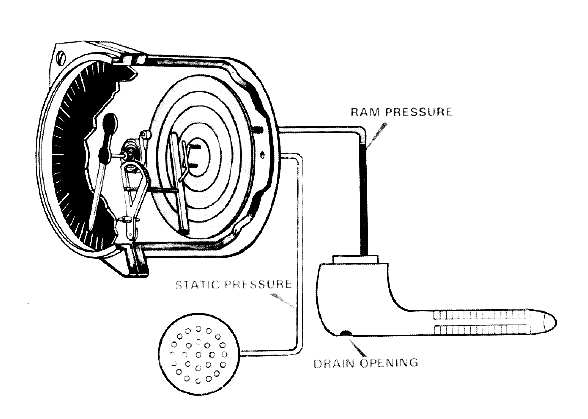
A basic airspeed indicator (From my first instrument flight manual, Air Force Manual 51-37, 1976, figure 1-2)
In a very basic system, airspeed is measured by taking the dynamic pressure entering the pitot tube and finding its way to the airspeed indicator where it pushes against a diaphragm which is opposed by the static pressure which comes from the static port through its own set of tubing. In essence: airspeed equals dynamic pressure minus static pressure. A modern system works basically the same way, except the dynamic pressure is fed to the Air Data Computer which converts it to numbers (analog to digital), does the same with static pressure, and then electronically transmits the results. The ADC can also make the necessary corrections so that the pilot sees Calibrated Airspeed (CAS) instead of Indicated Airspeed (IAS).
Altimeter
A basic altimeter is a barometer which measures outside air pressure from a static port which is piped into smalled sealed capsules with aneroid wafers inside. The capsules expand or contract, depending on the pressure, and mechanical linkages move a needle on a dial which is graduated in altitude. The calibration of the dial is adjusted according to barometric pressure. Some modern aircraft still use the sealed chambers and mechanical pickups, while others use solid-state pressure transducers. Many aircraft use Air Data Computers (ADCs) to share the digital information and make other adjustments. The key point is that even in a very modern aircraft, the system still depends on the static port and the tubing to whatever is used to sense the pressure.
The impact of pitot tube blockages
If the pitot tube is blocked while the airplane sits on the ground, the air in the pitot tube becomes sealed and what is supposed to be dynamic pressure now equals static pressure, which means your IAS = 0. Just what you would expect while stationary on the ground. As you accelerate for takeoff, static pressure hasn’t changed, so IAS is still zero. If one airspeed indicator displays 80 knots and the other display 0 knots during the 80-knot crosscheck, chances are good you have a blocked pitot tube or other problem on one side.
Once you takeoff things change. The static air pressure decreases as you climb and the value that should be dynamic pressure increases because there is less pressure against that diaphragm. In effect, the airspeed indicator has become an altimeter, indicating more "airspeed" as you climb, less as you descend.
It is possible that the blockage can be freed momentarily or permanently, due to vibration or other variables, causing a change that can indicate the problem is fixed or that the "baseline" reading is changed. This can be confusing and it might be best to continue to rely on other sources until the entire pitot-static system can be inspected.
The impact of static port blockages
A blocked static port will tend to "freeze" the altimeter on whatever reading it had when blocked, typically the airport's elevation if blocked while on the ground. It has a curious impact on the airspeed indicator, since the airspeed indicator reports the difference between dynamic pressure at the pitot tube minus the static pressure at the static port. The airspeed tends to show the speed indicated at time of blockage and then decreases with increased altitude because the air is less dense as you climb so the dynamic air pressure is decreased while the trapped static pressure stays the same. Conversely, the indicated airspeed increases as the aircraft descends.
As with the pitot tube, it is possible that the blockage can be freed momentarily or permanently, due to vibration or other variables, causing a change that can indicate the problem is fixed or that the "baseline" reading is changed. This can be confusing and it might be best to continue to rely on other sources until the entire pitot-static system can be inspected.
5
Better systems knowledge
(Going beyond what "they" teach you)
Many accident case studies illustrate times when had the pilot had just a little more knowledge, they could have avoided becoming a feature player of an aviation accident case study. The case of AeroPerú 603 is no exception:
- Pitot-static system. Most initial and recurrent courses assume basic knowledge of the pitot-static system is a given and that any differences with modern aircraft are minimal. It may be worthwhile to quiz yourself about the fundamentals, and you can start with the section above.
- Mode C transponders. How does Air Traffic Control know what altitude you are maintaining and how fast you are flying? Not too long ago, the answer to the altitude question was your Mode C transponder, which gets its data from your pitot-static system. More about this: Transponder. The answer to the speed question was the progress of your "blip" across his screen. These days, much of this information and more comes via your ADS-B Out data. More about this: ADS-B Out. In all cases, a better understanding of where the air traffic controller's data comes from may help you understand which data corroborates rather than just correlates.
- Stall barrier and Angle of Attack (AOA) systems. In an academic discussion, most pilots can tell you that a wing stalls when it exceeds its critical AOA but will instinctively cling to airspeed when practicing stall recoveries. Understanding what is driving your stick shaker (pusher, nudger, etc.) is critical when under duress. More about this: Stall Recovery and Angle of Attack.
- Radio altimeters. Just about every airplane I've flown with a non-military grade radio altimeter works about the same way. It sends out a radio wave downward and waits for the reflected signal to come back. The system calculates the time it took to do that and computes the distance the wave traveled, which translates to the aircraft's height above the ground or water. (Most studies show aircraft radio altimeters do well over water, but can be subject to inaccuracies over snow.) On most systems, the radio altimeter doesn't show altitude unless it is within 2,500 ft. of the surface. It is a reliable substitute for a barometric altimeter, if that barometric altimeter has failed. But a radio altimeter isn't affected by the barometric pressure, so when using the radio altimeter to fly an aircraft, there could be altitude conflicts with aircraft using barometric altimeters.
- EGPWS modes. Very few aircraft manuals cover EGPWS with sufficient detail. I got a copy of a very early EGPWS manual written by Honeywell back in 2003 and have never seen anything like it since. The AeroPerú 603 pilots discounted the validity of the "Too Low, Terrain!" warning because they were over water. That is understandable, given we are told the "E" part of EGPWS has a terrain database. I asked three versions of AI if this was possible and all three said you cannot get this warning over water. A careful examination of the manual begs to differ. The Mode 4A doesn't care about location: "Below 1000 feet AGL and above 190 knots airspeed, the Mode 4A aural alert is “TOO LOW, TERRAIN”. This alert is dependent on aircraft speed such that the alert threshold is ramped between 500 feet at 190 knots to 1000 feet at 250 knots."
- PIOSSE. A key benefit to having better systems knowledge is being able to better diagnose the problem. Having a structured way to approach a problem is key to avoiding panic. There are various methods out there, here is my favorite:
P – Problem: Identify what’s wrong (e.g., engine failure, abnormal indications).
I – Immediate Action: Perform any critical emergency memory items or boldface procedures that must be done without delay.
O – Options: Consider all feasible courses of action (e.g., divert, eject, continue, troubleshoot).
S – Select: Choose the best available option based on the situation.
S – Start Execution: Begin carrying out the selected course of action.
E – Evaluate: Continuously monitor the results and adjust as needed.
E – Execute Backup Plan (sometimes interpreted as a second evaluation or finalize execution depending on training context).
I think these pilots probably knew many of these things at some point in their careers, but they didn't know them well enough to recall them in their moments of stress. In aviation, it isn't good enough to learn something, you have to learn it well and you have to refresh your memory constantly. As the website says, "The learning never stops!"
6
An important last line of defense technique
(For this and many other situations)
If you ever find yourself with uncertain airspeed or altitude information you can sort things out, but it will take time. To buy yourself that time, it is vitally important that you set the pitch and thrust of the aircraft to known settings that will keep the airplane flying. For most aircraft, you only need to know values that will work at maximum weights during initial climb after takeoff, during cruise altitude, and in the approach environment. There are countless aircraft accidents, including AeroPerú 603, where this knowledge would have saved the day.
If your manufacturer doesn't provide this information, you should arrange these three scenarios in the simulator or record them during actual flight the next time you have the right conditions:
- Climb after takeoff, maximum weight
- Cruise at high altitude, after a maximum weight takeoff
- Missed approach, at maximum weight for landing
I've found over the years that the answer for the initial climb tends to be between 10 and 15 degrees of pitch at takeoff thrust, between 2 and 3 degrees at maximum continuous thrust for cruise, and between 10 and 15 degrees at just below maximum continuous thrust for a missed approach. You should record these either in the simulator or the aircraft when the opportunity arises.
Finally, if your aircraft has an Angle of Attack indicator that is usable for flight, you have another ace up your sleeve. Most cockpit AOA indicators are normalized, meaning they don't report the actual angle in degrees, but a ratio of that angle over the stall angle of attack. It is slightly more complicated than that, if you want to get into the nuts and bolts, see: Angle of Attack. You should scour your manuals and record values in the simulator. For many aircraft, you should see 0.66 NAOA on approach at VREF. As the NAOA increases, you are getting closer to the stall. In the Gulfstream GVII, for example, the stick shaker occurs at 0.97 NAOA.
References
(Source material)
AeroPerú Flight 603 Cockpit Voice Recorder (CVR), English Translation, available at https://tailstrike.com/database/2-october-1996-aeroperu-603/?utm_source=chatgpt.com
Instrument Flying, Air Force Manual 51-37, Department of the Air Force, 1 December 1976
Peru Ministry of Transport, Aircraft Accident Report, Accident of the Boeing 757-200 Aircraft, Operated by Empressa de Transporte Aereo Del Peru, Off the coast of Lima, 2 October 1996
